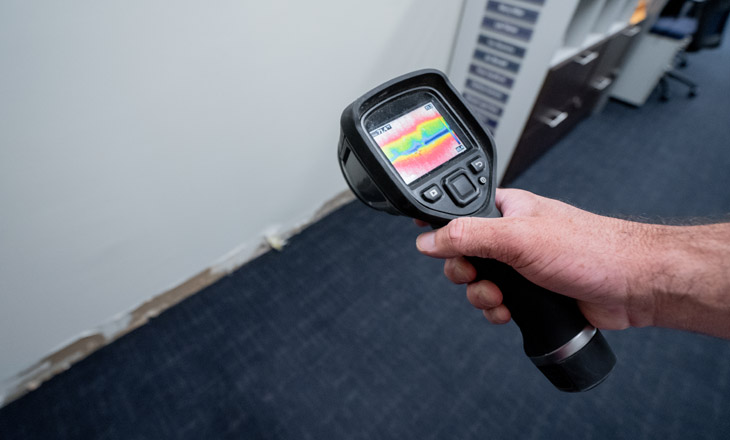Comprehensive Overview to Water Leak Detection for Homeowners and Organizations
Comprehensive Overview to Water Leak Detection for Homeowners and Organizations
Blog Article
Cutting-edge Solutions for Early Detection of Water Leaks in Buildings and Infrastructure
As the integrity of structures and facilities is extremely important, the obstacle of early discovery of water leakages has actually stimulated innovative solutions that promise to revolutionize the method we safeguard against possible damages. From advanced leak discovery modern technologies to the deployment of IoT sensors for real-time monitoring, the landscape of leak avoidance is advancing rapidly. Artificial intelligence algorithms provide a glance right into the future of leakage prediction, while thermal imaging presents a non-intrusive method for pinpointing surprise leaks. Automated water flow analysis systems are improving exactly how leaks are identified and dealt with, paving the method for a positive approach to water leakage detection. Each of these services holds the crucial to guaranteeing the integrity and durability of our built setting, triggering a shift in the direction of a much more lasting and reliable future.
Advanced Leakage Detection Technologies
Advanced leak discovery modern technologies, equipped with innovative sensors and formulas, play an essential function in promptly identifying and pinpointing water leaks in various settings. These innovations employ a combination of acoustic, thermal, and electro-magnetic sensing techniques to find leaks properly. Acoustic sensing units find the noise of escaping water, enabling accurate localization of the leakage source. Thermal imaging finds temperature modifications triggered by water leakage, offering an additional effective method for leakage recognition. Electro-magnetic sensing units can identify changes in magnetic fields triggered by water, supplying yet another layer of leak detection capacity.

IoT Sensors for Real-Time Surveillance
In the world of modern-day water leakage discovery, the integration of IoT sensors for real-time surveillance represents an essential improvement in enhancing proactive leak detection capabilities. These sensing units use continual surveillance of water systems, offering real-time data on water circulation prices, stress variations, and temperature adjustments. By leveraging IoT modern technology, these sensing units can find also the tiniest anomalies in water usage patterns, allowing very early identification of prospective leaks before they escalate right into major concerns.
IoT sensors send information to a centralized system, where advanced algorithms evaluate the information and create notifies or notifications when abnormalities are discovered. This real-time tracking capability permits homeowner or facility managers to promptly address leakages, decreasing water damages, decreasing fixing prices, and preserving water sources.
In addition, IoT sensing units can be integrated with building monitoring systems, enabling automatic reactions to discovered leaks, such as turning off water shutoffs or turning on pumps to reduce the impact of leaks. Generally, the application of IoT sensing units for real-time tracking substantially enhances the performance and performance of water leakage detection in structures and framework.
Device Knowing Algorithms for Leak Forecast

One trick benefit of utilizing maker knowing for leakage forecast is its capacity to constantly discover and improve its precision over time. As even more data is collected and fed right into the formula, it can improve its forecasts and adjust to changing conditions, eventually boosting the integrity of leak discovery systems.
Furthermore, artificial intelligence formulas can help in identifying refined signs of leaks that may this content go undetected by traditional monitoring techniques. water leak detection. By assessing intricate information sets in real-time, these formulas can supply very early cautions and informs, enabling for prompt intervention and preventative maintenance to minimize potential water damages and connected costs
Using Thermal Imaging for Leak Detection
Thermal imaging technology uses a promising method for identifying water leakages in various systems and facilities. By utilizing infrared radiation and temperature variances, thermal imaging video cameras can identify hidden leaks that are not quickly noticeable to the naked eye. When water runs away from pipelines or structures, it often changes the temperature level of the bordering location, developing temperature level differentials that thermal cams can record. These temperature level abnormalities are then converted into visible images, highlighting the specific location of the leak.
One of the essential benefits of thermal imaging for leakage detection is its non-intrusive nature. Overall, the usage of thermal imaging innovation enhances the performance and accuracy of water leakage discovery, making it a useful device for preserving the honesty of buildings and frameworks.
Automated Water Flow Evaluation Equipments
How can automatic water flow analysis systems change the discovery and administration of leakages in various systems and frameworks? Automated water flow evaluation systems offer an aggressive method to leakage discovery by continuously keeping track of water circulation rates and patterns. By establishing standard data, these systems can promptly recognize inconsistencies that may suggest a leakage, allowing punctual treatment to protect against substantial damage.
These systems utilize sophisticated formulas to evaluate real-time information and offer immediate alerts when abnormalities are spotted, enabling speedy activity to be taken. Additionally, automatic water flow evaluation systems can be integrated with building monitoring systems or IoT systems, enhancing overall effectiveness and enabling remote monitoring abilities.
Moreover, the data accumulated by these systems can be made use of for predictive maintenance functions, aiding to recognize possible weak points in the infrastructure prior to leaks take place. Generally, the implementation of computerized water flow analysis systems can dramatically boost leakage discovery and administration methods, ultimately leading to cost savings, minimized water wastefulness, and increased sustainability in buildings and infrastructure.

Verdict
In verdict, the integration of sophisticated over at this website leakage detection modern technologies, IoT sensing units, equipment knowing formulas, thermal imaging, and automatic water flow analysis systems uses ingenious options for early detection of water leaks in structures and framework. These modern technologies enable real-time surveillance, forecast of leaks, and reliable discovery why not try this out methods to avoid water damage and wastage. Executing these remedies can aid in maintaining the stability and sustainability of water supply in different setups.
Report this page